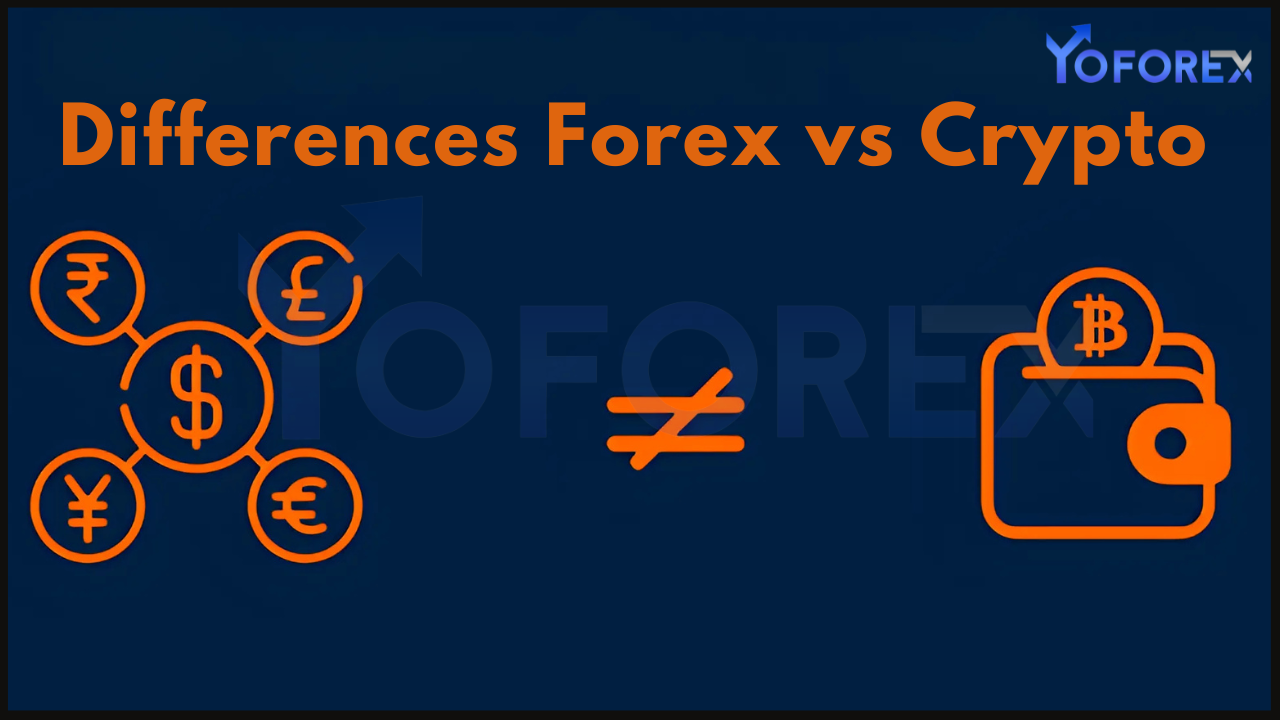Forex trading and cryptocurrency trading are two popular markets for investors looking to diversify their portfolios or generate profits through trading. While both involve the exchange of currencies, they differ significantly in terms of market structure, trading strategies, risk factors, and overall dynamics. Understanding these differences is crucial for traders aiming to excel in either market.
This blog delves into the key distinctions between forex trading and cryptocurrency trading, helping you decide which market aligns with your trading goals.
1. Market Overview
Forex Trading:
- Definition: Forex, or foreign exchange, involves trading national currencies like the US Dollar (USD), Euro (EUR), and Japanese Yen (JPY).
- Market Size: The forex market is the largest financial market globally, with a daily trading volume exceeding $7 trillion.
- Participants: Banks, corporations, governments, hedge funds, and individual traders.
- Purpose: Used for international trade, investments, hedging, and speculative purposes.

Cryptocurrency Trading:
- Definition: Cryptocurrency trading involves buying and selling digital currencies like Bitcoin (BTC), Ethereum (ETH), and Ripple (XRP).
- Market Size: The cryptocurrency market is relatively smaller, with a total market capitalization of over $1 trillion (as of recent data).
- Participants: Individual traders, institutional investors, blockchain developers, and miners.
- Purpose: Used for decentralized finance (DeFi), speculative trading, and as a store of value.
2. Market Hours
Forex Trading:
- Operates 24 hours a day, five days a week.
- Divided into four main trading sessions: Sydney, Tokyo, London, and New York.
- Offers consistent liquidity during trading hours.
Cryptocurrency Trading:
- Open 24/7, including weekends and holidays.
- No centralized market or trading sessions; trading occurs on various global platforms.
- Continuous trading allows for more flexibility but also demands constant monitoring.
3. Market Regulation
Forex Trading:
- Highly Regulated: Governed by financial authorities like the SEC (U.S.), FCA (U.K.), and ASIC (Australia).
- Transparency: Well-established rules ensure fair trading practices and investor protection.
- Centralized Infrastructure: Operates through interbank networks and regulated brokers.
Cryptocurrency Trading:
- Loosely Regulated: Regulation varies by country, with some nations adopting a pro-crypto stance and others banning it outright.
- Transparency Issues: The lack of standard regulations can lead to fraud, scams, and market manipulation.
- Decentralized Infrastructure: Operates on blockchain technology, with no central authority overseeing transactions.
4. Asset Volatility
Forex Trading:
- Moderate Volatility: Major currency pairs like EUR/USD and USD/JPY exhibit relatively stable price movements.
- Influencing Factors: Economic data, geopolitical events, and central bank policies drive price changes.
- Predictable Trends: Price action often follows established patterns, making technical and fundamental analysis effective.
Cryptocurrency Trading:
- High Volatility: Cryptocurrencies experience rapid price swings, with daily fluctuations often exceeding 10%.
- Influencing Factors: News, regulatory developments, market sentiment, and technology adoption impact prices.
- Unpredictable Trends: Price action can be erratic, influenced by speculative trading and market manipulation.
5. Liquidity
Forex Trading:
- High Liquidity: Major currency pairs offer deep liquidity, enabling traders to execute large orders without significant price impact.
- Tight Spreads: High liquidity results in low transaction costs, making forex trading cost-efficient.
Cryptocurrency Trading:
- Variable Liquidity: Liquidity varies widely among cryptocurrencies. Major coins like BTC and ETH have higher liquidity than altcoins.
- Wider Spreads: Lower liquidity in smaller coins leads to higher spreads and potential slippage.
6. Trading Instruments
Forex Trading:
- Currency Pairs: Traders deal with major pairs (e.g., EUR/USD), minor pairs (e.g., GBP/JPY), and exotic pairs (e.g., USD/TRY).
- Derivatives: Options, futures, and contracts for difference (CFDs) are also popular in forex trading.
Cryptocurrency Trading:
- Cryptocurrencies: Includes major coins like Bitcoin and altcoins like Dogecoin and Solana.
- Tokenized Assets: Some platforms offer tokenized versions of stocks, commodities, and other assets.
- Decentralized Finance (DeFi): Traders can engage in staking, yield farming, and liquidity provision.
7. Trading Platforms
Forex Trading:
- Well-Established Platforms: Platforms like MetaTrader 4 (MT4), MetaTrader 5 (MT5), and cTrader dominate the market.
- Broker-Based Access: Traders operate through regulated brokers offering platform access and leverage.
Cryptocurrency Trading:
- Exchanges: Platforms like Binance, Coinbase, and Kraken facilitate crypto trading.
- Wallets: Traders also use digital wallets for secure storage and direct transactions.
- Decentralized Exchanges (DEXs): Allow peer-to-peer trading without intermediaries.
8. Risk Management
Forex Trading:
- Risk Factors: Leverage, market gaps, and geopolitical events.
- Risk Mitigation Tools: Stop-loss orders, take-profit levels, and hedging strategies are common.
Cryptocurrency Trading:
- Risk Factors: Extreme volatility, regulatory uncertainty, and cybersecurity threats.
- Risk Mitigation Tools: Position sizing, diversification, and secure wallets help manage risks.
9. Leverage and Margin
Forex Trading:
- High Leverage Availability: Leverage ratios can range from 10:1 to 500:1, depending on the broker and regulation.
- Margin Calls: Strict margin requirements ensure traders maintain sufficient account balances.
Cryptocurrency Trading:
- Leverage Options: Many exchanges offer leverage, typically ranging from 2x to 100x.
- Higher Risks: Due to the extreme volatility of cryptocurrencies, leveraged positions can lead to rapid liquidation.
10. Trader Psychology
Forex Trading:
- Patience and Discipline: Traders often rely on consistent strategies and long-term planning.
- Predictable Reactions: Market trends and patterns are relatively stable, enabling traders to build confidence over time.
Cryptocurrency Trading:
- Emotional Trading: High volatility and speculative nature can lead to impulsive decisions driven by fear or greed.
- Rapid Decision-Making: The fast-paced market demands quick responses to changing conditions.
Conclusion
Forex trading and cryptocurrency trading offer unique opportunities and challenges. Forex trading is more stable, regulated, and liquid, making it ideal for traders seeking a structured environment. In contrast, cryptocurrency trading appeals to those looking for high volatility, decentralized markets, and innovative opportunities.
Choosing between the two markets depends on your risk tolerance, trading goals, and market knowledge. Regardless of your choice, proper education, disciplined strategies, and effective risk management are essential for success in either market.

